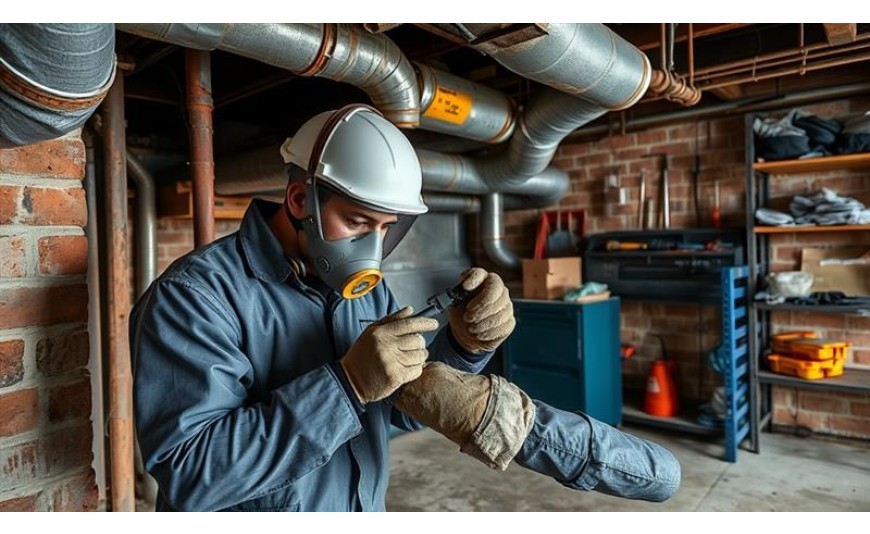
Hello, dear readers! Today, we're diving into a topic that might not be the most glamorous but is incredibly important for homeowners, especially those living in older houses: dealing with asbestos in HVAC ducts. If you’ve ever wondered what those mysterious fibers lurking in your home's infrastructure are, you’ve come to the right place. Let's unravel the mystery together!
What is Asbestos?
Before we delve into the nitty-gritty of dealing with asbestos, it's essential to understand what it is. Asbestos is a group of naturally occurring mineral fibers known for their strength and heat resistance. These qualities made asbestos a popular component in building materials throughout much of the 20th century.
Historical Context
Asbestos was extensively used from the 1940s to the 1970s in various building applications such as insulation, roofing, and notably, HVAC ducts. Its popularity stemmed from its fireproof nature and insulation properties. However, as the years passed, the health risks associated with asbestos exposure became apparent.
Why is Asbestos a Concern?
Inhaling asbestos fibers can lead to serious health issues, including asbestosis, lung cancer, and mesothelioma. The fibers are tiny and can become airborne, making them easy to inhale without noticing. This risk turns HVAC systems with asbestos into potential health hazards, as they can distribute these fibers throughout your home.
Real-world Scenarios
Imagine moving into a charming mid-century home, excited to savor its old-world charm. However, a few months in, you start experiencing respiratory issues. After some investigation, it turns out that your HVAC system contains asbestos, which has been circulating harmful fibers throughout your home. This scenario is not uncommon, especially in older homes.
Identifying Asbestos in HVAC Ducts
The first step in addressing asbestos in HVAC ducts is identifying its presence. This is where professional help becomes invaluable.
Professional Inspection
- Hire a Certified Asbestos Inspector: Look for professionals with experience in asbestos testing and removal.
- Testing: They will conduct a series of tests, often involving air sampling and material analysis, to determine the presence of asbestos.
Visual Cues
While not foolproof, there are some visual cues that might indicate the presence of asbestos in your ducts:
- Age of the Home: Homes built before the 1980s are more likely to contain asbestos.
- Material Type: Look for white or gray fibrous material; however, this can be misleading, as asbestos isn't always visible.
Dealing with Asbestos: Removal vs. Encapsulation
Once asbestos is confirmed, there are two primary routes to consider: removal or encapsulation.
Asbestos Removal
This process involves completely removing the asbestos material from your ducts. It's the most definitive way to eliminate the risk but also the most invasive and expensive.
Pros:- Eliminates the risk entirely.
- Ensures no future exposure.
Cons:- High cost.
- Requires temporary relocation during the process.
- Potentially damaging to the infrastructure if not done carefully.
Asbestos Encapsulation
Encapsulation involves covering the asbestos material with a sealant to prevent fibers from becoming airborne.
Pros:- Less invasive and more cost-effective.
- Quicker than removal.
Cons:- Not a permanent solution; regular monitoring required.
- Risk remains if the encapsulation is damaged.
Safety Precautions During Asbestos Handling
Regardless of the route you choose, safety is paramount.
Professional Help
Always enlist the help of certified professionals for asbestos handling. DIY methods are strongly discouraged due to the health risks involved.
Pre-Removal Safety Measures
- Seal Off the Area: Prevent asbestos fibers from spreading to other parts of the home.
- Use Protective Gear: Respirators, gloves, and suits are essential for anyone in the vicinity.
Post-Removal Measures
- Air Quality Testing: Ensure no fibers remain airborne after removal.
- Regular Monitoring: For encapsulated asbestos, frequent inspections are necessary to check the integrity of the encapsulation.
Current Trends and Future Implications
Technological Advancements
Today, there are more advanced methods and materials to handle asbestos safely. As technology progresses, expect to see more efficient and less invasive techniques for dealing with asbestos in homes.
Legislative Changes
Governments worldwide are tightening regulations concerning asbestos usage and removal. Staying informed about these changes can help you make better decisions for your home.
The Environmental Impact
It's not just about health; asbestos also has environmental implications. Proper disposal is crucial to prevent environmental contamination. Always ensure that the asbestos removal company you hire follows environmentally safe disposal practices.
Conclusion: Taking Action for a Safer Home
Dealing with asbestos in old HVAC ducts is not a task to be taken lightly. The health risks are significant, but with the right approach, you can make your home a safe and healthy environment. Remember:
- Identify: Confirm the presence of asbestos with professional inspections.
- Choose a Solution: Decide between removal and encapsulation based on your situation.
- Prioritize Safety: Always prioritize professional help and follow safety protocols.
By staying informed and proactive, you can protect yourself and your loved ones from the hidden dangers of asbestos. Let's ensure our homes remain sanctuaries of comfort and safety, free from the lurking threats of the past.
Happy home maintaining, and stay safe!
I hope you found this guide helpful. If you have any questions or personal experiences to share, feel free to leave a comment. Let's keep the conversation going and learn from each other. Until next time!












Write a comment